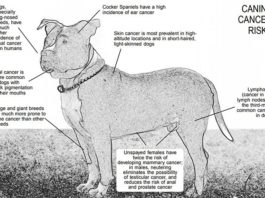Chemotherapy for Dogs: What to Expect
Cancer. My heart dropped to my stomach. In February 2010 my Border Collie Daisy became one of an estimated six million dogs diagnosed with cancer each year. Chemotherapy. My stomach tumbled to my feet. The diagnosis was scary enough; how could I possibly consider chemotherapy? I had visions of a treatment worse than the disease itself. As it turns out, my preconceptions of chemotherapy were far worse than its reality. Chemo hasn't cured my dog more on that later but it's given us more than 18 months (and counting) of joyful, quality time together.
Is Cancer Prevention for Dogs Possible?
What could be better than curing your dog's cancer? That's easy! How about avoiding the illness in the first place? No one has done any clinical trials or statistical studies that prove you can prevent cancer in at-risk dogs. But common sense and clinical experience make a strong case for avoiding anything that exposes an animal to known carcinogens or weakens the immune system
New Hope for Treating Cancer
An herbal extract from China is showing great promise in slowing cancer growth, and giving dogs more quality time with their guardians. When researchers at the Chinese Institute of Material Medicine discovered a region of China that did not have malaria, they found that its people drank a decoction (simmered tea) of Artemesia annua L. at the first sign of malarial symptoms.
Studies Have Linked Lawn Pesticides with Canine Malignant Lymphoma
It's a ton of fun to see an athletic, healthy dog sprinting across a sprawling lawn of thick green grass but could this practice be dangerous to the dog's health? A study presented in the January 2012 issue of the journal Environmental Research concluded that exposure to professionally applied lawn pesticides was associated with a significantly (70 percent) higher risk of canine malignant lymphoma (CML). It's a broad conclusion and light on specifics. The case-control study, conducted between January 2000 and December 2006 at the Foster Hospital for Small Animals at Tufts University's Cummings School of Veterinary Medicine, was structured around a 10-page questionnaire that was mailed to dog owners who were having their pets treated at the Foster Hospital; the resulting data came from the owners of 266 dogs with confirmed cases of CML and 478 dogs in two control groups (non-CML cases).
Reduce Your Dog’s Cancer Risks
Veterinary oncologists say that cancers in humans and in dogs are incredibly similar, in terms of growth and prognosis. That's good news for both species, as research of human or canine cancer may yield insight about and new treatments for this deadly disease. In addition, many of the tactics that reduce the incidence of cancer in humans, veterinary oncologists say, can be used by pet owners to reduce the chances that their dogs will develop the disease. Here are four things you can do to help prevent cancer in your dog.
Neutering Saves Lives by Reducing Cancer Risks
Most people respond with a warm fuzzy Awwww" reaction when they see a litter of puppies. After all
Signs of Cancer in Dogs
Weight loss may be the first sign of cancer in dogs and can be easy to miss at home. As your dog ages, your veterinarian will likely recommend bloodwork, urinalysis, and other diagnostics. These can detect changes in organ function, possibly indicating cancer.
Cancer Treatments for Dogs
In conventional veterinary medicine, cancer treatments consist primarily of surgery, chemotherapy, and radiation. While research in these areas has brought significant advances, the overall picture is discouraging; cancer death rates are largely unchanged. While many canine cancers are treated successfully when diagnosed early, more often the therapies, conventional or holistic, simply buy some additional time for the animal. In standard canine treatment protocols, a 12-month remission is considered a cure." While a year of dog's life is a relatively long time
A New Bone Cancer Vaccine for Dogs
Osteosarcoma is the most common type of bone tumor diagnosed in dogs, affecting an estimated 10,000 dogs each year in the U.S. alone. Too many owners are aware that this disease can be extremely aggressive with a poor prognosis.
Best Treatment Options for Canine Lipomas
Uh-oh. What’s this lump? Any growth on your dog’s body deserves attention, especially one that wasn’t there last time you checked. It could be a sebaceous cyst (a sac filled with sebum, a cheesy or oily material, caused by clogged oil glands in the skin), an abscess (a pus-filled swelling caused by infection), or – everyone’s worst nightmare – a cancerous tumor. But in most cases, the lumps we discover as we pet and groom our dogs are lipomas, which are benign (non-cancerous) fat deposits, also known as fatty tumors. An estimated 1.7 million dogs are treated in the United States for lipomas every year, and according to one survey, American veterinarians average 25 lipoma removals annually at a cost to owners of $635 million. Lipomas tend to emerge as dogs reach middle age and increase in number as dogs get older. A dog with one lipoma is likely to get more. Lipomas are most often found on the chest, abdomen, legs, or armpits (axillae). These fatty lumps aren’t painful and they usually stay in one place without invading surrounding tissue.
New Hope for Treating Osteosarcoma On the Horizon
Many dogs do just fine after amputation necessitated by osteosarcoma. A new vaccine may help them continue to enjoy life even longer.
One Answer to Cancer
when I came across a book called Give Your Dog A Bone by Dr. Ian Billinghurst

















